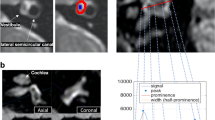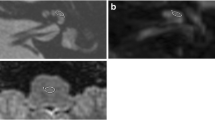Abstract
In animals, the enhancement of perilymph in the cochlea has been reported using 1.25 mmol/kg of Gd-DTPA, allowing the separate visualisation of perilymph and endolymph for the diagnosis of Meniere's disease. The purpose of this study was three-fold: (1) to determine the optimal timing for detecting cochlear fluid enhancement using 3D-FLAIR (fluid-attenuated inversion recovery) after intravenous administration of 0.1 mmol/kg of Gd-DTPA in healthy human subjects; (2) to examine the reliability of enhancement in multiple healthy subjects; and (3) to investigate whether endolymph and perilymph space can be visually discriminated. In two healthy subjects, 3D-FLAIR images were obtained before, immediately after and 2 h, 4 h and 6 h after the injection. Three more healthy subjects were scanned before and 4 h after the injection. In all four ears of the initial two subjects, cochlear fluid was found to be most intensely enhanced 4 h after the injection. In all of the additional three subjects, the cochlear fluid signal had increased after 4 h from injection. However, visual differentiation of endolymph and perilymph fluid could not be achieved. Using 3D-FLAIR and Gd-DTPA, cochlear fluid enhancement can be observed in healthy human ears, even with a single dose of contrast-medium injection.



Similar content being viewed by others
References
Schuknecht HF, Gulya AJ (1983) Endolymphatic hydrops. An overview and classification. Ann Otol Rhinol Laryngol Suppl 106:1–20
Niyazov DM, Andrews JC, Strelioff D, Sinha S, Lufkin R (2001) Diagnosis of endolymphatic hydrops in vivo with magnetic resonance imaging. Otol Neurotol 22:813–817
Koizuka I, Seo Y, Murakami M, Seo R, Kato I (1997) Micro-magnetic resonance imaging of the inner ear in the guinea pig. NMR Biomed 10:31–34
Ito T, Naganawa S, Fukatsu H, Ishiguchi T, Ishigaki T, Kobayashi M, Kobayashi K, Ichinose N, Miyazaki M, Kassai Y (1999) High-resolution MR images of inner ear internal anatomy using a local gradient coil at 1.5 Tesla: correlation with histological specimen. Radiat Med 17:343–347
Xenellis JE, Linthicum FH Jr, Webster P, Lopez R (2004) Basilar membrane displacement related to endolymphatic sac volume. Laryngoscope 114:1953–1959
Counter SA, Bjelke B, Borg E, Klason T, Chen Z, Duan ML (2000) Magnetic resonance imaging of the membranous labyrinth during in vivo gadolinium (Gd-DTPA-BMA) uptake in the normal and lesioned cochlea. Neuroreport 11:3979–3983
Deliganis AV, Fisher DJ, Lam AM, Maravilla KR (2001) Cerebrospinal fluid signal intensity increase on FLAIR MR images in patients under general anesthesia: the role of supplemental O2. Radiology 218:152–156
Maeda M, Tsuchida C (1999) "Ivy sign" on fluid-attenuated inversion-recovery images in childhood moyamoya disease. AJNR Am J Neuroradiol 20:1836–1838
Naganawa S, Koshikawa T, Nakamura T, Kawai H, Fukatsu H, Ishigaki T, Komada T, Maruyama K, Takizawa O (2004) Comparison of flow artifacts between 2D-FLAIR and 3D-FLAIR sequences at 3 T. Eur Radiol 14:1901–1908
Griswold MA, Jakob PM, Heidemann RM, Nittka M, Jellus V, Wang J, Kiefer B, Haase A (2002) Generalized autocalibrating partially parallel acquisitions (GRAPPA). Magn Reson Med 47:1202–1210
Frigon C, Shaw DW, Heckbert SR, Weinberger E, Jardine DS (2004) Supplemental oxygen causes increased signal intensity in subarachnoid cerebrospinal fluid on brain FLAIR MR images obtained in children during general anesthesia. Radiology 233:51–55
Anzai Y, Ishikawa M, Shaw DW, Artru A, Yarnykh V, Maravilla KR (2004) Paramagnetic effect of supplemental oxygen on CSF hyperintensity on fluid-attenuated inversion recovery MR images. AJNR Am J Neuroradiol 25:274–279
Mugler JP 3rd, Bao S, Mulkern RV, Guttmann CR, Robertson RL, Jolesz FA, Brookeman JR (2000) Optimized single-slab three-dimensional spin-echo MR imaging of the brain. Radiology 216:891–899
Naganawa S, Koshikawa T, Nakamura T, Fukatsu H, Ishigaki T, Aoki I (2003) High-resolution T1-weighted 3D real IR imaging of the temporal bone using triple-dose contrast material. Eur Radiol 13:2650–2658
Counter SA, Bjelke B, Klason T, Chen Z, Borg E (1999) Magnetic resonance imaging of the cochlea, spiral ganglia and eighth nerve of the guinea pig. Neuroreport 10:473–479
Author information
Authors and Affiliations
Corresponding author
Rights and permissions
About this article
Cite this article
Naganawa, S., Komada, T., Fukatsu, H. et al. Observation of contrast enhancement in the cochlear fluid space of healthy subjects using a 3D-FLAIR sequence at 3 Tesla. Eur Radiol 16, 733–737 (2006). https://doi.org/10.1007/s00330-005-0046-8
Received:
Accepted:
Published:
Issue Date:
DOI: https://doi.org/10.1007/s00330-005-0046-8




